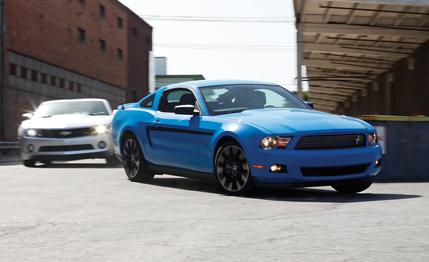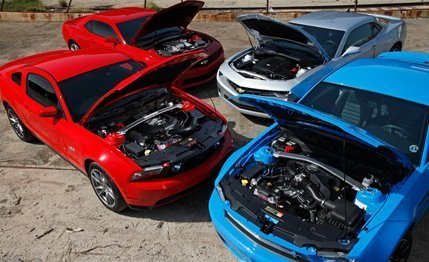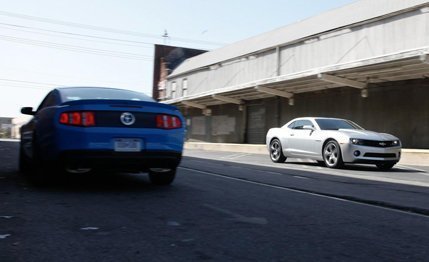
 Comparison Tests
Comparison Tests
You’re forgiven if you feel you may have seen this movie before, because you probably have. Like Hamlet, or Macbeth, its core is a classic confrontation that never seems to get old, thanks to the arrival of new players and fresh productions, as one generation succeeds another.
You may be thinking, “New? Don’t see no new here.” With little more than a year in Chevy showrooms, the Camaros roll into summer unchanged. And it takes the experienced eye of a longtime Mustang cognoscente to see the updates for these 2011 models. The dashboard surface is revised, softened to make impacts with one’s head a little less unpleasant. There are also suspension tweaks aplenty, but the real giveaway is a 5.0 badge on the flanks of GT models.


That badge panders to hallowed memories of the Mustang’s revered old Windsor V-8 (1979–’95), which, as any member of the Mustang club will admit, fell 58 cc short of 5.0 liters. Ford’s 4.6-liter V-8s never seemed to eclipse memories of the not-quite-5.0, but it may be a different story with this barely 5.0 (4951 cc) successor. All aluminum, double overhead cams, 32 valves, variable valve timing on all four cams, a high compression ratio (11.0:1), four-bolt mains—the new V-8 shares bore centers but little else with the 4.6.
Ford stopped short of direct injection, saving about $200 per engine, but output is potent nevertheless: 412 horsepower at 6500 rpm, 390 pound-feet of torque at 4250—burlier by 97 horses and 65 pound-feet. There’s also a new V-6 for the base Mustang, a more vigorous version of the 3.7-liter aluminum engine found in the Lincoln MKS and MKT: 305 horses and 280 pound-feet of torque.
With Mustang’s power now comparable to Camaro’s across the board, these two longtime rivals needed another face-off. We rounded up our four-horse field in Los Angeles and drove to Buttonwillow Raceway Park, near Bakersfield. Some of the results were predictable. But there were surprises, too.


Buyers strap themselves into V-6 pony cars because they like the look but don’t require V-8 muscle. Or, more accurately, they don’t need that power enough to fork over the additional seven or eight grand for two more cylinders.
In the past, this has meant a pony car severely deficient in giddyup, something particularly true of the base Mustang’s old boat anchor, the 4.0-liter V-6.
But these are no longer children of a lesser god. The V-6 Camaro and Mustang both come to the starting gate with more than 300 horsepower, as well as distinctly better fuel economy than their quicker stablemates.
So being thrifty no longer means having to give up fun to drive. But just how much of the FTD factor is retained? That’s what we set out to determine.

